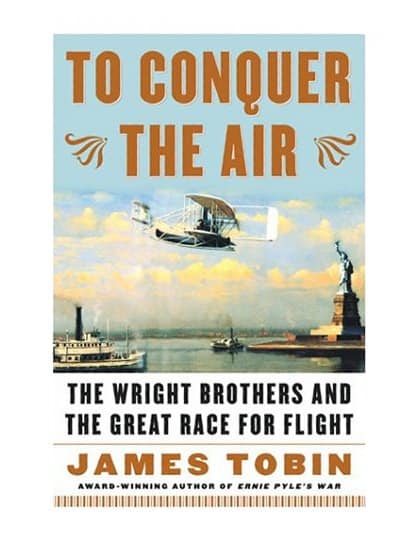- 1885 – In Craigellachie, British Columbia, construction ends on the Canadian Pacific Railway extending across Canada.
- 1910 – The first air freight shipment (from Dayton, Ohio, to Columbus, Ohio) is undertaken by the Wright Brothers and department store owner Max Moorehouse.
- 1994 – WXYC, the student radio station of the University of North Carolina at Chapel Hill, provides the world’s first internet radio broadcast.
The first commercial airplane flight in history was carried out by Wright Company pilot Philip Parmalee, who transported two bolts of silk (worth $1,000) from Dayton, Ohio, to Columbus, for delivery to the Morehouse-Martens Department Store in Columbus.
For more on the Wright Brothers, read To Conquer the Air: The Wright Brothers and the Great Race for Flight.
This extraordinarily well-written and deeply nuanced work is the best of the recent spate of books celebrating the Wright Brothers and the 100-year anniversary of their invention of the airplane. Award-winning biographer Tobin (Ernie Pyle’s War) provides a detailed yet truly exciting tale of the brothers’ lifelong effort to stand “against the wave of popular doubt about the possibility of human flight.†The book’s strength resides in Tobin’s careful depiction of two main elements of the Wright story. First, Tobin provides the fullest and most sympathetic account yet written of the close-knit Wright family and the impact of its ethic-“the Wrights versus the worldâ€-on the brothers, at the same time that he recaptures the personal qualities that were forgotten after they became aviation icons. (“Will had a devastating dry wit, but there was more fun in Orville.â€) Second, Tobin is stunningly effective in presenting the intertwining lives of the brothers and an amazing cast of friends and competitors, including such inventors as Samuel Langley, secretary of the Smithsonian and creator of the doomed Aerodrome, and his friend and fellow flight enthusiast Alexander Graham Bell; Octave Chanute, one of the brothers’ earliest supporters; and Glenn Curtiss, the brothers’ main competitor. Tobin’s final chapter, which details Wilbur Wright’s historic flight in 1909 circling Manhattan, is a definitive account of the crowning final triumph of the Wrights’ career.
